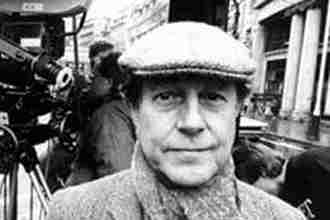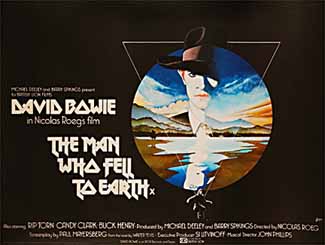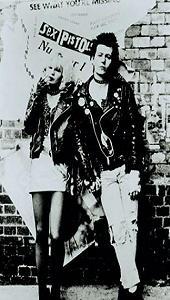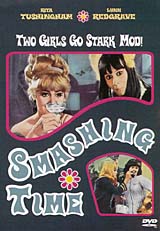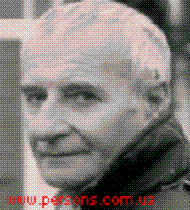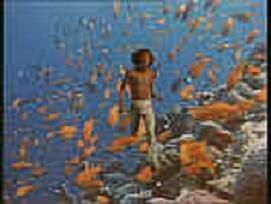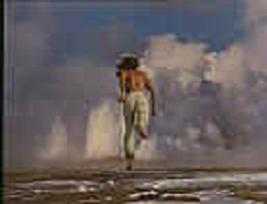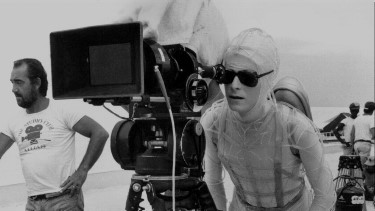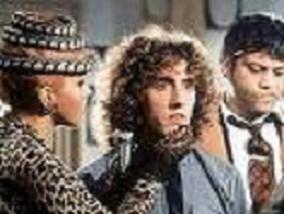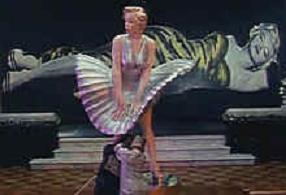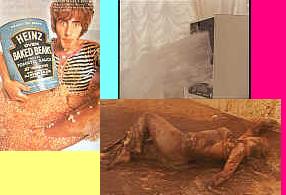 | New Cinema in Britain |
|
Nicolas Roeg |
|
O Lucky Man! Alan Price |
|
Sid and Nancy |
|
Lindsay Anderson |
|
Ken Russell''s style |
Ken Russell''s style |
The Man Who Fell to Earth (with David Bowie) |
|
Ken Russell''s Tommy |
Ken Russell''s Tommy |
Ken Russell''s Tommy |
POSTWAR BRITISH CINEMA and BRITISH FILM HISTORY http://www.open2.net/castandcrew/study.html
During the War - literary adaptation. Too many films from classic literary, even Alexander Pushkin.
1944 - Henry V
1945 - Caesar and Cleopatra (George Bernard shaw)
1947 - An Ideal Husband (oscar Wilde)
1947 - Oliver Twist
1948 - Hamlet
1955 - Richard III
Intelligent comedias - another big genre. But the mid-1950s, British cinema had began to decline into cliche , and Britain was ance again in danger of becoming a Hollywoood colony.
THE FREE CINEMA MOVEMENT - which , like Italian neorealism, celebrate a manifesto "the importance of the individual...the significance of the everyday". In 1947, the Oxford University film journal Sequence (1947-52), edited by the future directors Lindsay Amderson (1923-94)and Karel Reisz, started the Free Cinema movement. In practice, Free cinema meant the production of short, low-budget documentaries about of working-class life.
BRITISH "NEW CINEMA'', OR SOCIAL REALISM.
saturday night and Saturday Morning - are prototype of British New Cinema, a social-realist film movement. Major New Cinema production include
1961 - A Taste of Honey (Tony Richardson)
1962 - The Lonelines of the Lond Distance Runner (Woodfall)
1962 - A Kind of Loving (John Shlesinger)
1963 - The Leather Boys (Furie)
1963 - Billy Liar (John Shlesinger)
1963 - This Sporting Life (Lindsay Anderson)
1966 - Morgan:A Suitable Case for Treatment (Karel Reisz)
During the mid-1960s, in fact, a reaction to the breacness of social realism set in, and the depressing images of the industrial Midlands were replased by those of "swinging London" in big-budget widescreen color production like Alfie (1966), Smashing Time (1967), Joanna (1968), all of which did have working-class protagonist. Nevertheless, Lindsay Anderson continuet to pursue antiestablishment themes in "if..."(1968), a brilliante film about the nature the individualism and authority cast in the form of a surrealist satireon the British public school system.One the most important film "if..." can be favorably compared with Vigo''s Zero de conduite (1933), to which it contains several explicit allusions; it established Anderson as the most influential figure to emerge from the New Cinema movement. In Anderson''s powerful O Lucky Man!(1973), whose mock-poetic title refers back to his first film, O Dreamland (1953), the protagonist of "if..."continues his educationthrough the various levels of corruption in London society, only to be totally corrupted himself at the end of the process - by being "discovered" by the director Lindsay Andersonto star in a motion picture entitled O Lucky Man!The film Britannia Hospital (1982)continued Andersson''s dissection of the contemporary British psyche in an unsparing absurdist satire on labor strikes, racial tensions, and the misuse of the National Health Service by doctors and patients alike.
1987 - The Whales of August (L.Anderson)
1959 - Room at the Top (Jack Clayton)
1960 - The Legaue of Gentlemen (Basil Dearden)
1961 - Whistle Down the Wind (Bryan Forbes)
1963 - The Mind Benders (Basil Dearden)
1963 - The L-Shaped Room (Bryan Forbes)
1963 - Tom Jones (Tony Richardson)
1964 - Seance of a Wet Afternoon (Bryan Forbes)
1964 - The Pumpkin Eather (Jack Clayton)
1965 - King Rat (Bryan Forbes)
1965 - The Loved One (Tony Richardson)
1965 - Darling (John Schlesinger)
1966 - Khartoum (Basil Dearden)
1966 - The Wrong Box (Bryan Forbes)
1966 - Morgan :a suitable Case for Treatment Karel Reisz)
1967 - The Whisperers (Bryan Forbes)
1967 - Deadfall (Bryan Forbes)
1967 - Our Mother''s House (Jack Clayton)
1967 - Far from the Midding Crowd (John Schlesinger)
1968 - Isadora (Karel Reisz)
1968 - The Chardge of the light Brigade (Tony Richardson)
1969 - Midnight Cowboy (John Schlesinger)
1970 - The Raging Moon (Bryan Forbes)
1970 - Ned Kelly (Tony Richardson)
1971 - Sunday, Bloody Sunday (John Schlesinger)
1974 - The Great Catsby (Jack Clayton)
1975 - The Day of the Locust (John Schlesinger)
1975 - The Gambler Karel Reisz)
1976 - Marathon Man (John Schlesinger)
1977 - Josef Andrews (Tony Richardson)
1978 - Who''ll Stop the Rain?Karel Reisz)
1979 - Yanks (John Schlesinger)
1980 - Honky Tonk Freeway (John Schlesinger)
1981 - The Border (Tony Richardson)
1981 - The French Lieutenant''s WomenKarel Reisz)
1982 - Something Wicked this Way Comes (Jack Clayton)
1983 - An Emglishmen Abroad (John Schlesinger)
1984 - The Falcon and the Snowman (John Schlesinger)
1984 - The Hotel New Hampshire
1985 - Sweet Dreams Karel Reisz)
1986 - The Believers (John Schlesinger)
1987 - The Lonely Passion of Judith Hearne ( Briam Moore)
1988 - Madame Sousatzka (John Schlesinger)
1990 - Pacific Heights (John Schlesinger)
1990 - Everybody Wins Karel Reisz)
1991 - A Question of Attribution (John Schlesinger)
1991 - Blue Sky (Tony Richardson)
1993 - The Innocent (John Schlesinger)
1995- Cold Comfort Farm (John Schlesinger)
Another filmmakers:Ronald Neame (b1911), Peter Watkins (b.1935)Joseph Losey (1909-84), Richard Lester (b.1932)
A Taste of Honey - from the "kitchen sink" stage play by Shelagh Delaney. Rita Tushingham plays a working-class British teenager, living with her drink-sodden, libertine mother Dora Bryan. Denied affection by her selfish mother, Tushingham is pushed further in the background when Bryan impulsively marries her latest boyfriend Robert Stephens. The girl takes a job at a shoe store, then moves in with her kindly homosexual employer Murray Melvin. The two lost souls live in harmony until Tushingham becomes pregnant after a casual affair with black sailor Paul Danquah. Melvin comes to the rescue by offering to look after the baby. This relatively blissful state of affairs is short-lived; before long, Tushingham''s hateful mother, having been kicked out by Stephens, descends upon her daughter and her "family," with all her debilitating emotional baggage intact. A poignant denouement caps this riveting slice-of-life drama.
the one of the most significant British films of the twentieth century, The Loneliness of the Long Distance Runner. In a post-film discussion Kirsty Wark leads an exploration of the trends in British film-making at the time, looking at the relationship between cinema and society, as well as highlighting the art and craft behind each film-maker''s vision.
The Loneliness of the Long Distance Runner is a bleak and powerful film about a rebellious social misfit who is picked to be part of his reform school''s track team. The runner, played by Tom Courtenay, is a determined, defiant young man who confronts society and its institutions head on. Using ground-breaking camera techniques the film is a powerful portrayal of young people in Britain at the beginning of the sixties.
Saturday Night and Sunday Morning - The film, with its graphic portrayal of sex, violence and urban reality, was the inspiration for a number of features that would document the lives of ordinary Britons in a way that had never been seen before. Set in a working-class estate in Nottingham, the film documents the central character''s disdain for authority. Arthur Seaton, played by Albert Finney, is a handsome but nonconformist factory worker, stuck in a dead end job who is alienated from his parents and fellow workers.
A hand grenade of a film, it makes you laugh even as your blood chills", 1968''s If... shot the actor, Malcolm McDowell to fame, confirmed the reputation of Lindsay Anderson as one of the most important film directors of the 20th century, and coincided with the waves of radical student riots in Europe, America and Japan in the late nineteen sixties.
THE END OF SOCIAL REALISM in the late 1960s.90% by 1968 - american directors, they cameto work in British studios.
The two most original British directors of the 1970s were undeniable Ken Russell (b 1927) and Nicolas Roeg.
David Bowie as THe Man Who Fell to Earth (Nicolas Roeg, 1976). Audiovisual Images with psychologist affect.
The primal elements (fire, water, earth, air) crop up regularly in Russell films. Like painting in primary colours, the elements allow powerful images. Objects suddenly burst into flame. A favourite image by Ken is of the reflection of sun on water. Waterfalls are almost always used for sex. He also uses locations around the lake district. Kites in the air often appear -http://www.iainfisher.com/russell/russte.html
Ken Russell gave Tommy in 1975 (The Who''s rock opera), Listomania (1975) - text http://ourworld.compuserve.com/homepages/tommys/tommytxt.htm
После того, как Расселл экранизировал "Томми" The Who, и фильм имел большой коммерческий успех, ему неожиданно стали предлагать крупнобюджетные проекты. Но, к сожалению, за этим последовал фильм, специально рассчитанный на большие кассовые сборы, а после провала "Валентино" Кен Расселл перестал считаться коммерчески успешным режиссером.
Томми (Tommy)
Рок опера Пита Тауншенда, некоторые сцены в которой были изменены, чтобы придать сюжету смысл.
Рассказывается о ребенке, который стал свидетелем того, как его мать и ее любовник убили его отца. Мать (которая работала на фабрике по производству шарикоподшипников) говорит ему, чтобы он никому не рассказывал о том, что он видел и слышал. И он становится глухим, немым и слепым. Но у него есть один дар---он умеет играть в пинбол (настольная игра, в которой игрок, выпустив с помощью поршня шарик, пытается попасть в лузы, расположенные на игольчатой поверхности). Шары в пинболе выглядят так же как и шарикоподшипники, которые изготовляют на фабрике, где работает его мать. Также они идентичны шарам в медицинском устройстве, которое одевают Томми на глаза по указанию доктора (которого играет Джек Николсон). Томми становится культовой фигурой для своих последователей, до тех пор, пока они не осознают, что им тоже придется стать глухими, немыми и слепыми.
Фильм снят по альбому. Становилось модно делать тематические альбомы, и Пит Тауншенд опередил многих, введя в свой альбом сюжетную линию (хотя некоторые композиции в нее и не вписываются). Сюжет был навеян блюзами "Eyesight for the Blind" ("Зрение для слепого") Сонни Бой Вилльямсона (Sonny Boy Williamson). И самая знаменитая песня "Pinball Wizard" ("Волшебник электронного бильярда") была добавлена в альбом, чтобы в нем гарантированно был сингл---хит.
Фильм представляет собой поток видео образов
В церкви Деву Марию заменяет Мэрилин Монро. Под ее статуей блондинки в масках Монро раздают причастие----виски и таблетки.Но она оказывается свергнутым идолом.Томми отвергает эту религию, и попытки Тины Тернер пробудить в нем способность чувствовать при помощи секса и наркотиков тоже ни к чему не приводят.
"Если Ваш ребенок не стал тем, кем уже должен быть, эта девушка ему поможет. Я покажу ему, кем он уже мог бы быть, дайте мне только еще одну ночь".
Томми становится знаменитым и превращается в нового мессию, за которым следуют толпы. Его мать и отчим этим пользуются.
сцена сделана по мотивам обложки альбома The Who "The Who Sell Out" ("Распродажа The Who"), на которой Долтри (в протест против коммерциализации) сидит в ванной, наполненной печеными бобами Heinz Beans. Расселл и сам в свое время снимал рекламу печеных бобов и моющих средств (в его рекламном ролике, для того, чтобы показать, как легко пена от моющего средства уходит в сток, сняли сначала, как эту пену накачивают в раковину, а потом записали ролик из конца в начало).
Самый зрелищный несчастный случай произошел, когда снимали огонь на пирсе Саусси----пламя вдруг разгорелось не на шутку, и пирсу был нанесен серьезный ущерб.
Кен смонтировал кадры с настоящим пламенем и кадры, в которых Долтри бежит сквозь огонь.
Конечно же играют The Who. Роджер Долтри играет Томми и, к счастью, молчит почти весь фильм. В отличие от Долтри, Кит Мун---единственный из The Who кто умеет играть, и он наслаждается своей ролью дяди Эрни, мучающего маленького Томми.
Другие рок-звезды, такие как Элтон Джон (Волшебник электронного бильярда) и Тина Тернер (Кислотная королева) замечательно зрелищны в своих видео отрывках. Элтон Джон возможно сыграл бы одну из ролей в "Радуге" Кена Расселла, но он позже передумал.
эрик клептон был накачан наркотиками, пришлось пригласить Артура Брауна.Оливер Рид играет отчима, Энн-Маргарет играет мать. Джек Николсон играет доктора.
Церковь поклонения Мэрилин Монро, когда ряды Мэрилин идут по проходу.Танцоры в противогазах в сценах бомбардировки Лондона.Бег через поля.Волшебник электронного бильярда Элтон Джон.Кислотная королева Тины Тернер.В "Томми" много ссылок на другие фильмы Кена Расселла, от фильмов времен работы на BBC (сцены с водопадом) до "Малера" (Роберт Пауэлл и скалы). Сцена с поездом напоминает приезд Фэнби в "Дэлиусе", а слепого и парализованного Дэлиуса можно назвать прототипом "Томми". Сцена с зеркалами и ребенком напоминает "Бартока", коридоры напоминают монастырь в "Дьяволах".
Имеются ползающие по скелету змеи.Долтри появляется в целом ряде христианских образов: распятие, прогулки по воде, прогулки по берегу в обществе рыбаков ("я сделаю вас ловцами человеков").Он спускается на Ангелов Ада с неба (как небесный ангел) и при этом отражается в темных очках одного из Ангелов (как в "Дэлиусе").Способы "лечения" напоминают "Заводной апельсин" Кубрика. - http://www.iainfisher.com/russell/rus/rsrfi26.html
Листомания (Lisztomania) - Фильм о Листе с музыкой Рика Вэйкмэна.Существо (не то голем не то Франкенштейн---Вагнер, которого убил Лист и которого оживила его дочь Козима) с электрогитарой, которая на самом деле оказывается пулеметом, идет через гетто, убивая евреев, и его сопровождают дети, одетые в костюмы, напоминающие костюм супермена. В окне, имеющем форму свастики, Козима видит чье-то лицо, вытаскивает куклу Вуду и протыкает ее иглой, чтобы убить человека, которого она изображает. Да, это именно история Листа.Фильм задуман как сексуальная комедия, но получилось не очень смешно. Беспрерывный поток визуального воображения, "Листомания" это самый нестандартный и необычайный из всех фильмов Кена Расселла.
В то время, как в фильмах о Малере и Чайковском были отдельные великолепные сцены (например, увертюра 1812г. в "Любителях музыки", сцена обращения в католическую веру в "Малере"), в фильме о Листе Расселл нашел в себе свободу для полного, ничем не сдерживаемого самовыражения. Этот фильм следует признать самой экстравагантной биографией классического композитора из всех, когда-либо созданных. В реальной жизни Лист был мастером шоу, он первый сел боком к зрителю и исполнял пассажи
Сид и Нэнси:
Оригинальное название - Sid and Nancy
Жанр - драма
Год - 1986
Режисер - Алекс Кокс
Актеры - Гэри Олдмэн, Клои Уэбб, Дрю Скофилд
Продолжительность фильма - 1:53:22
Качество фильма - Хорошее
Описание фильма Сид и Нэнси - Эпическая драма о жизни и смерти Сида Вишеса, фильм о сумасшедшем времени - 70-х, о рок музыке, о становлении и распаде Sex Pistols, о любви, о поисках свободы и разочарованиях.... Первый значимый фильм Гэри Олдмэна, игра Олдмэна и Уэбб настолько убедительна, что фильм кажется документальнымРежиссер: Алекс Кокс /Alex Cox/
Описание: Великолепно поставленныйй фильм о ненормальных, саморазрушительных взаимоотношениях между звездой панк-рока 1970-х Сидом Вишиосом (из группы "Секс Пистолз") и американкой Нэнси Спанген, приведших их к трагической и ранней смерти.
The Man Who Fell to Earth
Books about Sid and Nansy
SOCIAL REALISM FILMS
Кен Расселл
Линдсэй Андерсон
